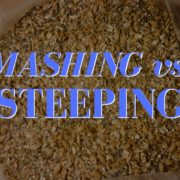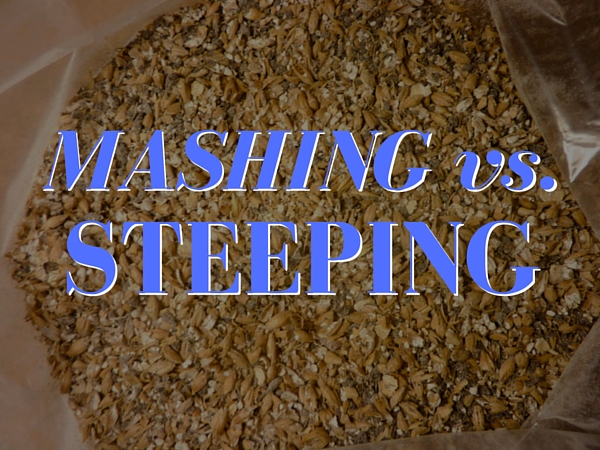Steeping vs. Mashing Grain. What’s The Difference?
At first glance mashing and steeping seem like very similar processes. When you look at what’s happening, it’s hard to discern one from the other, they both involve soaking crushed malt and grain in hot water for a set duration of time. The differences of course relate to what we are trying to achieve in these processes and this is where the contrasts become apparent.
In this article we’re going to look at the differences between steeping grain and mashing as well as explore what makes one separate from the other.
Mashing is the process of soaking grains at a specific temperature that activates enzymes whose job it is to break down starch, stored within the grain. The key point of mashing is to convert starch into fermentable sugars, this is one of the first stages of the all grain brewing process. A side effect of mashing, is you extract colour and flavour from the grain in the recipe.
While the main focus of mashing is to breakdown starch into fermentable sugars, steeping on the other hand is primarily used to extract colour and flavour. In most instances steeping is carried out before adding malt extract to the beer. Malt extract is where the bulk of the fermentable material will come from. If you are an extract brewer you are not concerned about activating enzymes to break down starch, as this process has already been carried out when the malt extract was produced.
The reason for steeping grains, is to add layers of flavour and add colour to what would otherwise just be just a malt extract base. A beer made using just malt extract with no grains steeped would be the equivalent of just using pale malt on it’s own. This isn’t bad it is a very good base for many beers but steeping grains will add further dimensions to a beer
Almost all the grains that are suitable for steeping have already had the starches converted to sugars during the malting process. These grains are called speciality malts and include a whole range of crystal malts as well as roasted grains. Crystal malts undergo a malting process that converts the starch in the grain to simpler sugars before being kilned, that conversion gives them a crystalline structure hence the name. Roasted malts are highly kilned in some cases till they are completely black, this high heat treatment degrades the starch molecules and denatures all the enzymes contained in the malt.
The problem that can occur if you are steeping base malts that contain lots of starch, is that the starch ends up in the finished beer. Unconverted starch will produce a fairly strong haze in any beer and will muddy the flavour slightly, which is never a good thing.
Key Differences Between Mashing and Steeping
Temperature and duration, these are the practical differences between the two processes, plus the equipment needed.
As mentioned above the goal of mashing is to convert starch to fermentable sugars, this requires the activation of enzymes held within the grain. The key enzymes that break down starches are alpha amylase and beta amylase and they work most effectively within set temperature ranges. Read more about enzymes and their key temperature ranges here.
When we mash grain then we want to hit a target temperature that is most suited to breaking down starch molecules. This is usually within the range of around 64°C – 68°C and is called a saccharification rest.
Another key part of mashing is the duration, the saccharification rest is called a rest as it takes a certain amount of time for conversion to take place. The mash is usually held over 60 minutes as this is optimal for almost all of the starch conversion to take place. Too short and you may not break down all the starch and too long would waste time.
Steeping on the other hand is all about capturing the flavour compounds of malts and grain and also extracting colour. There is no starch in the grain to worry about and also in most cases no enzymes present in the grain at all.
As we aren’t concerned with activating enzymes the temperature we steep at isn’t as much of an issue. It is widely considered that a steep at around 70°C or a range between 65°C to 75°C is most effective at drawing out colour and flavour from specialty malts. Too hot risk extracting bitter and astringent tannins and too cool is less effective at extracting the flavour and colour.
Time is the next difference. Generally you can steep grain for as little as 15 minutes and be done. The steeping is to extract flavour remember so you can move onto the rest of the brewing as soon as you think you have enough. Most brewers steep grain between 15 – 30 minutes and I usually just go for 15 minutes myself.
Equipment For Mashing vs. Steeping
One key difference between mashing and steeping we haven’t touched upon yet is the equipment you need to do it. Steeping grain is a lot less equipment intensive than mashing during an all grain brewday.
Extract brewing uses only a small amount of grain, usually less than 1kg. You steep grain in a nylon or muslin bag. The bag acts like a big tea bag in which water can soak all the grain and move freely around, extracting flavour and colour. After 15 minutes or more you simply lift the bag out, which is still fairly light, rinse with a little hot water to get the last of the steeping liquor out and move on.
Mashing on the over hand is in most instances more involved. As we are using the grain to extract fermentable sugars you need a lot more grain to begin most home brewers making around 21 litres/5 gallons or more will use a dedicated mash tun. These are usually insulated vessels or picnic coolboxes that have been modified with taps.
The grain mashes at the correct temperature for an hour or more. The wort is drained and then the grain is lautered by rinsing it with more hot water. The lauter uses around the same or more water than the mash and can take between 15 – 30 minutes before you move on with the rest of the brewing process.
It is possible to mash in a grain bag like you would use to steep in. I have done so myself and there is a growing contingent of all grain brewers using the BIAB method (brew in a bag). It is more suited to smaller batches in my opinion as the more grain you try to use the larger the vessels you need to mash and boil and the heavier the grain bag.
Steeping During A Mash?
A technique I have seen used more and more as well as something I have done myself is steeping grains during a mash.
This is particularly good for dark and roasted grains. The idea is to add a portion of dark or roasted grain to the mash during the last few minutes. The idea is that you will add a large amount of colour to the wort but a more mellow and less roasted or bitter flavour. A short sttep like this seems to make sense and it does indeed quickly add colour at the end of the mash, how much it affects the flavour in terms of the addition being more mellow for instance is debateable.






Leave a Reply
Want to join the discussion?Feel free to contribute!